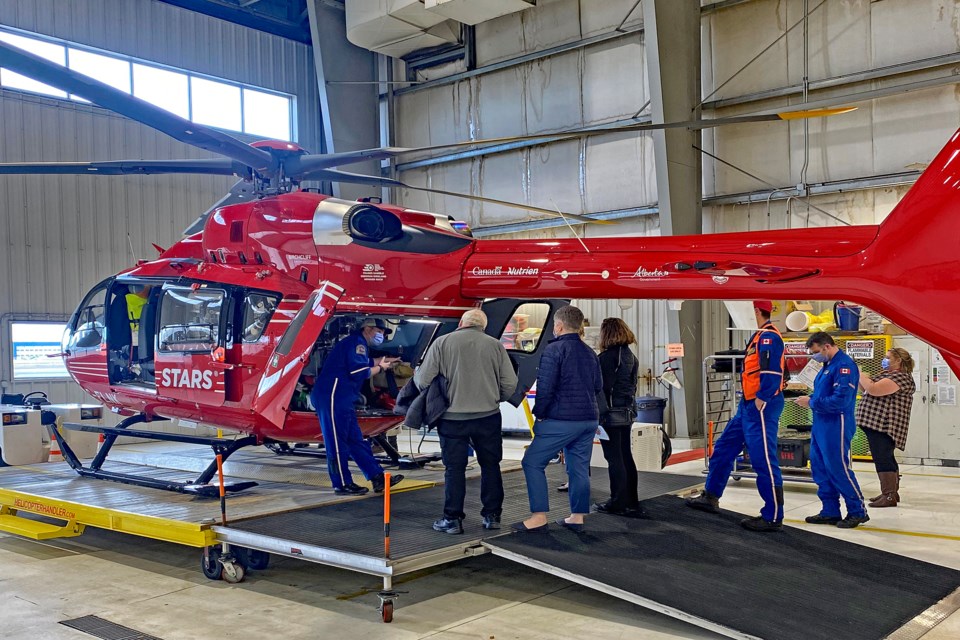INNISFAIL – STARS officials rolled out the red carpet for Innisfailians to show their appreciation for the town’s passionate commitment to upgrade its heliport and the 31 years of committed financial support from the Innisfail Royal Canadian Legion Branch #104.
On Jan. 26, council members Dale Dunham, Gavin Bates and Janice Wing, along with Mayor Jean Barclay, Rotary Club of Innisfail member Michelle MacDonald, and Don Harrison, the interim manager of the Innisfail legion, toured the Calgary base of STARS.
The tour included the hanger for the new H145 helicopters, a simulation lab, the Emergency Operations Centre, administration offices, and crew ready rooms.
“One of the members of the (STARS) team that was there was actually on the helicopter the day they flew into Innisfail last November for their first transport and he raved about the heliport’s improvements that were made,” said Barclay. “Everybody from the moment you walked in were so welcoming, and so grateful to Innisfail for investing in a new heliport.”
Harrison, who is also a member of council, played a big part in organizing the visit.
He initiated the tour idea late last year when he contacted STARS, noting the legion has donated close to $300,000 from its 50/50 draw to the air ambulance serviced since 1991.
“I just wanted to make sure that everybody knew we were still contributing and they were very, very appreciative,” said Harrison, who invited STARS officials to attend the official opening of the upgraded heliport, which is expected in spring.
Late last summer the $641,541 upgrade to the 24-year-old heliport was completed, two and a half years after it was shut down due to non-compliance with numerous Transport Canada guidelines.
STARS officials made a point on Jan. 26 to show their appreciation by presenting Harrison with a framed print of a landed STARS helicopter in a field.
When the Innisfail delegation arrived at STARS’ base at YYC Calgary International Airport at about 1 p.m. on Jan. 26 they were met by Martin Ebel, STARS’ municipal and donor relations and development officer, and Glenda Farnden, the agency’s senior municipal relations liaison.
“We took them to the hangar first and we spent quite a bit of time there. It was kind of nice because we had two pilots, flight nurse, flight paramedic, and for a while the odd duty doctor came,” said Ebel, adding STARS’s new H145 helicopter was one of the highlights of the tour. “They had plenty of opportunities to interact with the crew and ask questions and see the stretcher in the back and how it pops out.
“They were extremely engaged, extremely interested.”
Emergency air ambulances have come a long way from what most people know from watching the old MASH movie and television show.
STARS current H145 air ambulances are bigger, faster and ultra-super high tech to serve the needs of three prairie provinces, as well as northeast and southeast British Columbia.
There are 10 new H145 helicopters with STARS. They began arriving in 2019 with a unit price of $18 million each.
The new H145 is considered a “flying intensive care unit”; a modern helicopter that outperforms the previous BK117 model in nearly all key performance areas.
“It was 30 years of evolution that went into the H145; avionics, fuselage construction – everything about it,” said Ebel. “It's just a much newer helicopter that incorporates the latest technological and aeronautical engineering, safety and navigation. All of that is much more updated.”
The airspeed of the H145 is about 230 kilometres an hour, which is about 10 per cent faster than the BK117.
The H145 can fly about 30 per cent greater range than the BK117.
“Typically, this means we can fly approximately one hour 20 minutes or approximately 300 kilometres out, from and back to a base, without needing to refuel,” said Ebel.
He said the H145 can fly three times higher than the BK117 on high altitude/high temperature missions; a maximum ceiling of about 20,000 feet depending on several variables, including weight, weather, fuel, and distance to a landing zone.
“It's absolutely amazing. There is more critical care on that helicopter then there is probably in a lot of rural hospitals,” said Barclay, who was given a chance to sit in the H145 for a close interior look. “It's just amazing to see what they can do for a patient while in transit. They have blood on board, pharmaceuticals, ultrasound, and they can intubate somebody if they have to.
“There was a couple of pilots, as well as the medical team, we met on that particular shift and to see the passion they have for their work is also amazing.”



